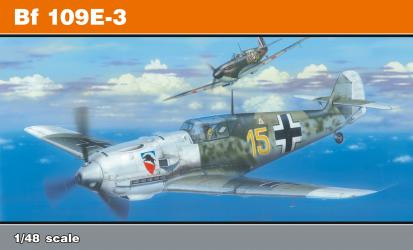
Eduard Bf109E-3 ProfiPACK
By Jacob Russell
This is a reissue of Eduard's Messerschmitt Bf109E-3 in the ProfiPACK boxing. It's a multimedia kit of injection molded plastic and photo-etch. It consists of 192 parts, 133 of which are plastic on 5 sprues, plus a sheet of rice paper masks. 26 of the plastic parts are surplus and destined for your spares box.
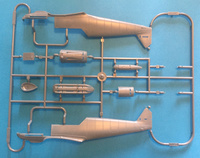
|
The surplus parts are applicable to later Emil variants such as the E-4 and E-7. They include the 300 litre drop tank and rack, the ETC 50/VIIId and ETC 500/IXb bomb racks, and a single SC 250 and 4 SC 50 bombs. The Emil was pressed into service during the Battle of Britain, so these bombs and racks cater to the fighter/bomber variants while the drop tank is for the late E-7. The clear sprue includes 6 parts, including the armored windscreen of the E-4 and E-7.
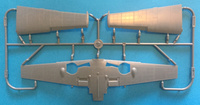
|
There are 49 PE parts on 2 frets, one of consists of mostly pre-painted items. These include a new instrument panel, seat harness, starboard sidewall console, etc. The non painted parts provides items such as the rudder pedals, oil cooler and wing radiator faces, and the chain for the landing gear retraction wheels. The masks includes the windscreen and canopy.
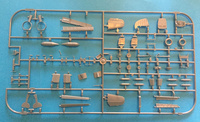
|
The quality of Eduard's injection molding is above reproach. The surface detail consists of rivets and both raised and recessed panel lines where appropriate. The rudder and ailerons are molded separately and the fabric effect is well depicted. The wing radiator flaps and leading edge slats are also individual pieces.
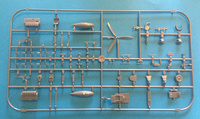
|
The E-3 includes a complete engine and it will be an impressive sight with wiring and plumbing. The engine area also includes the upper cowling mounted MG 17 machine guns. You can build the model with an open cowling and machine gun bay. You get most of the makings of a convincing maintenance diorama.
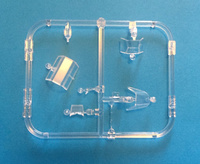
|
A ProfiPACK boxing also means that you have 5 colorful decal options to choose from:
-
-
-
“Yellow 12”, Ruff. Karl Wolff, 3./JG 52, Pihen/Calais, France, August 1940. This aircraft had the standard early scheme of RLM 02/71/65 with the Light Blue 65 extending up the fuselage sides. The fuselage sides were over painted with a dense mottle of 02 and 71. The wing upper surfaces were RLM 02/71. The RLM 65 extended over the wing leading edges and the nose, gun cowlings, rudder and wing tips were white. The spinner was half white and RLM 70 Dark Green.
-
“Yellow 1”, Oblt. Josef Priller, CO of 6./JG 51, France, Autumn 1940. This VERY colorful aircraft, which underwent several camouflage modifications during its career, also had the standard early scheme of RLM 02/71/65. The Light Blue 65 extended up the fuselage sides. The port fuselage side was over painted with a heavy application of RLM 71 with 02 mottling under the horizontal stabilizer. The starboard fuselage had a heavy over spray of RLM 02 with dense RLM 70 under the canopy area. The wing upper surfaces were RLM 02/71 with a non standard application. The nose and rudder were RLM 04 yellow and the spinner was white with an RLM 70 Dark Green backing plate.
-
“Black Chevron”, Obstlt. Hans-Hugo Witt, CO of JG 26, Dortmund, Germany, April 1940. This plane was RLM 02/71 over 65, with the 02 and 71 carried low down the fuselage sides. The upper wings were in a standard RLM 02/71 pattern, with an RLM 65 rudder and RLM 70 spinner.
-
“White 7”, 1./JG 2, Bassenheim, Germany, May 1940. This plane was RLM 02/71 over 65, with the 65 carried high up the fuselage sides. The upper wings were in a standard RLM 02/71 pattern, with an RLM 70 spinner.
-
“Yellow 3”, 3./JG 51, Mannheim-Sandhofen, This plane was RLM 02/71 over 65, with the 2 colors all the way down the fuselage sides. The upper wings were in a standard RLM 02/71 pattern, with an RLM 70 spinner, the cowling gun troughs were RLM 04 Yellow, and the upper and lower wing Balkenkreuze were much larger than standard. The spinner was RLM 70 Dark Green with an RLM 04 Yellow tip.
-
-
The 2 decal sheets (one for markings and one for air frame stencils) are up to Eduard's usual standards with crisp, bright colors and blacks. They are legible and in-register.
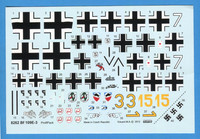
|
The instruction sheets follow Eduard's customary pattern with a brief Bf109 history, parts map, a well illustrated and logical build sequence, color aircraft profiles, stencil decal application guide, and color call outs for GSI Creos (Gunze) Aqueous and Mr. Color paints. This is a great presentation.
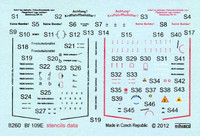
|
The Messerschmitt Bf109 Emil is one of my favorite World War II planes. Eduard has done the aircraft justice with this reissued kit. It is accurate and well detailed. You can produce a great model right out of the box or you can upgrade the kit with some of Eduard's Brassin and PE sets. The Emil was a colorful aircraft and all of the decal options are interesting. If you don't like the kit markings there are plenty of aftermarket sheets to choose from. I recommend this kit and I would like to thank Eduard for the review sample.
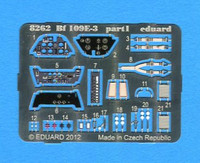
|
|
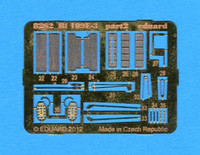
|
References
Messerschmitt Bf109E, The Blitzkrieg Fighter, by Marek J. Murawski, Jakub Plewka, Kagero Publications, 2013
